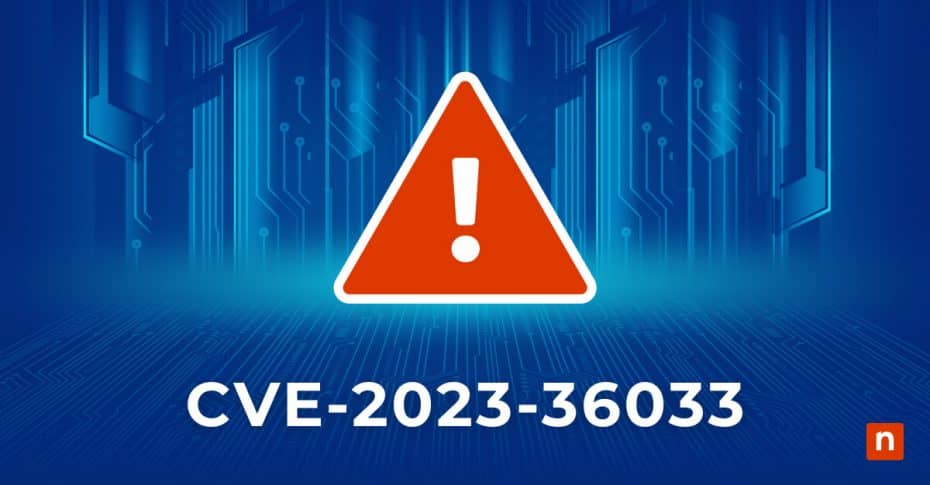Understanding Microsoft CVE-2023-36033 is crucial for IT professionals, cybersecurity experts, system administrators, and other tech-savvy individuals focused on safeguarding their systems from vulnerabilities.
This guide aims to provide a comprehensive overview of CVE-2023-36033, detailing its nature, significance, and potential impact. It will cover how this vulnerability was discovered, the technical specifics, possible consequences if exploited, and the necessary steps for mitigation and patching.
What Is Microsoft CVE-2023-36033?
CVE-2023-36033 is a specific vulnerability identified in Microsoft systems. It has been assigned a unique identifier within the CVE system to facilitate tracking and resolution. This vulnerability impacts certain versions of Microsoft’s software and poses significant security risks if not addressed promptly.
CVE-2023-36033 addresses a flaw in the authentication mechanism of a Microsoft service. This flaw allows attackers to bypass security controls, potentially gaining unauthorized access to sensitive data and system resources. The vulnerability affects:
- Authentication services: The authentication services affected by CVE-2023-36033 are primarily those related to Windows Authentication Methods. This vulnerability in the Windows Desktop Window Manager (DWM) Core Library impacts several Windows authentication services and can lead to privilege escalation if exploited.
- Windows operating systems versions:
| Product | Build Number |
| Windows Server 2022, 23H2 Edition (Server Core installation) | 10.0.25398.531 |
| Windows 11 Version 23H2 for x64-based Systems | 10.0.22631.2715 |
| Windows 11 Version 23H2 for ARM64-based Systems | 10.0.22631.2715 |
| Windows 10 Version 22H2 for 32-bit Systems | 10.0.19045.3693 |
| Windows 10 Version 22H2 for ARM64-based Systems | 10.0.19045.3693 |
| Windows 10 Version 22H2 for x64-based Systems | 10.0.19045.3693 |
| Windows 11 Version 22H2 for x64-based Systems | 10.0.22621.2715 |
| Windows 11 Version 22H2 for ARM64-based Systems | 10.0.22621.2715 |
| Windows 10 Version 21H2 for x64-based Systems | 10.0.19043.3693 |
| Windows 10 Version 21H2 for ARM64-based Systems | 10.0.19043.3693 |
| Windows 10 Version 21H2 for 32-bit Systems | 10.0.19043.3693 |
| Windows 11 version 21H2 for ARM64-based Systems | 10.0.22000.2600 |
| Windows 11 version 21H2 for x64-based Systems | 10.0.22000.2600 |
| Windows Server 2022 (Server Core installation) | 10.0.20348.2113 |
| Windows Server 2022 (Server Core installation) | 10.0.20348.2091 |
| Windows Server 2022 | 10.0.20348.2113 |
| Windows Server 2022 | 10.0.20348.2091 |
| Windows Server 2019 (Server Core installation) | 10.0.17763.5122 |
| Windows Server 2019 | 10.0.17763.5122 |
| Windows 10 Version 1809 for ARM64-based Systems | 10.0.17763.5122 |
| Windows 10 Version 1809 for x64-based Systems | 10.0.17763.5122 |
| Windows 10 Version 1809 for 32-bit Systems | 10.0.17763.5122 |
Discovery and disclosure of CVE-2023-36033
CVE-2023-36033 was discovered by a team of security researchers from the renowned cybersecurity firm DBAPPSecurity WeBin Lab. The discovery occurred during a routine security audit in early 2023, highlighting the importance of regular security assessments. The researchers identified anomalous behavior in the authentication process, leading to the detection of this vulnerability.
Upon discovering CVE-2023-36033, the researchers followed a responsible disclosure process. This involved:
- Notifying Microsoft: Providing detailed information about the vulnerability.
- Collaborating with security experts: Working with Microsoft’s security team to develop a patch.
- Public disclosure: Announcing the vulnerability only after a patch was made available to protect users.
Technical details of CVE-2023-36033
CVE-2023-36033 involves a flaw in the handling of authentication tokens. The vulnerability arises from improper validation of these tokens, allowing attackers to forge or manipulate them. This technical flaw can be exploited through authentication token forgery and privilege escalation.
Attackers can exploit CVE-2023-36033 through:
- Crafting malicious requests: Attackers exploit CVE-2023-36033 by sending specially crafted packets or authentication requests to the Windows DWM Core Library. These requests bypass normal validation processes, often transmitted over the network or internet, exploiting systems exposed via services like Remote Desktop Protocol (RDP).
- Gaining unauthorized access: This vulnerability allows attackers to gain unauthorized access to restricted system areas by bypassing security controls after initial exploitation. They can access sensitive data, modify configurations, or install malicious software, escalating privileges from regular users to system-level accounts and facilitating broader network breaches.
Potential impact of CVE-2023-36033
While specific case studies for CVE-2023-36033 might not yet be available, this vulnerability led to Kaspersky researchers’ documented discovery of another privilege escalation bug, which would arguably count as indirect evidence of its real-world use. If CVE-2023-36033 is exploited, it can lead to severe consequences, including full-system (i.e. whole-network) compromise and subversion, data breaches and thefts of customer data and/or valuable intellectual property, and general service disruptions.
CVE-2023-36033 mitigation and patching
Mitigating CVE-2023-36033 involves the following actions:
-
- Apply patches: Always install the latest security- and system updates from Microsoft. Only remain on affected versions of Windows if you have exceedingly good reasons – in which case opting for a paid subscription live-patching service seems like a good idea.
- Monitor systems: Regularly check for signs of exploitation. Though third-party tools can be extremely useful here, especially in remote monitoring situations, Windows Defender has been considered by many credible publications and specialist forums as the best free Windows antivirus- and security scanner in recent years
- Strengthen controls: Implement additional security measures, such as multi-factor authentication.
- Ensure meatspace security: Ensuring the integrity of your physical-layer access controls is especially critical here – the privilege exploit can be triggered from the login screens both for full Windows Server as well as for Windows Server Core Installation instances.
Microsoft has released patches to address CVE-2023-36033. These patches are available through Windows Update, or downloadable from the CVE issue page itself on Microsoft’s bug tracker website. To protect against CVE-2023-36033, system administrators should regularly update systems, conduct security audits to assess systems for vulnerabilities, educate users, and promote awareness of security best practices.
Preventive measures for vulnerabilities
Improving cybersecurity and preventing similar vulnerabilities involves key strategies. Regular updates keep software and systems current, protecting against known vulnerabilities. Security training educates staff to recognize and respond to threats, while robust authentication, like multi-factor authentication and strong passwords, adds extra protection against unauthorized access.
Regular system updates and patch management are crucial for maintaining a secure and efficient IT environment. They close security gaps by addressing known vulnerabilities, enhance system performance, and ensure compliance with industry standards and regulations – avoiding potential legal and financial repercussions.
Stay informed to maintain robust cybersecurity practices
In this guide, we explored Microsoft CVE-2023-36033, detailing its nature, discovery, technical aspects, potential impact, and mitigation steps. Understanding this vulnerability is crucial for maintaining robust cybersecurity practices. Regular updates, continuous monitoring, and proactive security measures are key to defending against emerging threats and ensuring system integrity.








